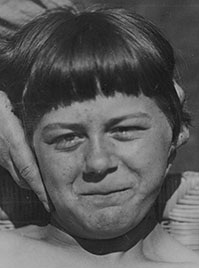Search for Names, Places and Biographies
Already layed Stumbling Stones
Suche
Käthe Anna Erna Willbrandt * 1911
Stormarner Straße 42 (Wandsbek, Wandsbek)
HIER WOHNTE
KÄTHE ANNA ERNA
WILLBRANDT
JG. 1911
EINGEWIESEN 8.5.1920
ALSTERDORFER ANSTALTEN
"VERLEGT" 16.8.1943
HEIL- UND PFLEGEANSTALT
AM STEINHOF WIEN
ERMORDET 16.9.1944
Käthe Anna Erna Willbrandt, born on 17.6.1911 in Wandsbek, admitted to the Alsterdorf Asylum ("Alsterdorfer Anstalten", now Evangelische Stiftung Alsterdorf) on 8.5.1920, deported to Vienna to the "Wagner von Jauregg – Curative and Nursing Home of the City of Vienna” ("Wagner von Jauregg-Heil- und Pflegeanstalt der Stadt Wien") on 16.8.1943, died there on 16.9.1944
Stormarner Straße 42 (Wandsbek)
Käthe Willbrandt was born on 17 June 1911 in the then Prussian town of Wandsbek and was baptized on 3 Dec. in the Christchurch (Christuskirche) in Wandsbek. Her parents, laborer Henri Johann Karl Willbrandt, born 22 Aug. 1887 in Marlow, in the then Duchy of Mecklenburg-Schwerin, and his wife Maria Emma Sophie, née Mahncke, born 4 Jan. 1885, in Wandsbek, had married there on 18 Apr. 1911. The family lived for many years at Stormarner Straße 42 in Wandsbek.
Käthe Willbrandt had two younger sisters: Annemarie, born on 9 Sept. 1912, and Luise, born on 19 Oct. 1913. Annemarie successfully completed secondary school, Luise elementary school.
Käthe Willbrandt was born prematurely. In infancy she did not develop according to her age, and as early as March 1912 a handicap became apparent.
From 1914, Maria Willbrandt had to look after her three daughters alone: her husband had taken part as a steward in the maiden voyage of the luxury liner MS "Vaterland" to New York and had never returned. Henri Willbrandt was considered missing since 1922. (The district court of Wandsbek declared him dead in 1955 on 31 Dec. 1925).
On the basis of a medical report initiated by the magistrate of the city of Wandsbek, Käthe Willbrandt was admitted to the Alsterdorf Asylum (Alsterdorfer Anstalten, now Evangelische Stiftung Alsterdorf) on 8 May 1920. According to the report, she suffered from "idiocy" (an outdated term for a severe form of intelligence impairment), as well as twitching and paralysis of both legs. She could neither walk nor stand. Käthe Willbrandt could not speak, but could make herself a little understandable by signs.
Until her admission to the Alsterdorf Asylum, Maria Willbrandt had taken care for her disabled daughter alone. The magistrate of the city of Wandsbek also considered Käthe Willbrandt's admission to an institution necessary so that her mother could earn a living for her two other daughters.
Little is known about Käthe Willbrandt's life in Alsterdorf. In the early years she was fed, enjoyed playing with dolls and looking at picture books. By the end of 1925/beginning of 1926, she was able to eat alone, sit alone, and was also capable of performing minor activities. In 1931, Käthe was found to be almost unable to hear.
Käthe's mother was concerned about her child during his stay in Alsterdorf. She visited Käthe and often brought her home for visits, in 1938 together with the patient Anita Bölck, who came from Alt-Duvenstedt and was approximately the same age. In 1941, the staff described Käthe Willbrandt as mostly calm and tolerable; in 1943, it was noted that she was washed, combed, dressed and undressed, and fed. Apparently, earlier abilities had been partially lost again.
During the heavy air raids on Hamburg at the end of July/beginning of August 1943 ("Operation Gomorrah"), the Alsterdorf Asylum also suffered bomb damage. After consultation with the health authorities, the management of the institution took the opportunity, to transfer some of the residents who were considered to be "weak in labor, in need of care or particularly difficult" to other sanatoriums and nursing homes. On 16 Aug. 1943, a transport with 228 women and girls from Alsterdorf and 72 girls and women from the Langenhorn sanatorium and nursing home left to Vienna to the "Wagner von Jauregg Sanatorium and Nursing Home of the City of Vienna", also known as the "Steinhof Institution." Among them were Käthe Willbrandt and her friend Anna Bölck.
In the "Wagner von Jauregg Sanatorium and Nursing Home of the City of Vienna", patients were systematically murdered by overdosing on medication, by not treating illnesses, but above all by depriving them of food.
In the Vienna asylum, Käthe Willbrandt's weight was initially given as 40 kg. On admission, she had been quiet, her feet were crippled, she could not walk, was unclean and in need of care. By October she had already lost two kilograms, and in December another two kilograms. In February 1944, Käthe Willbrandt lost weight rapidly, one kilogram every month. The last entry in the weight table for July 1944 read: 27 kilograms. She had lost a third of her weight in that year since her admission to the asylum in Vienna.
Käthe Willbrandt died on 16 Sept. 1944, at the age of 33. The cause of death was noted in the patient's file as "marasmus," which can be translated as high grade emaciation as a result of severe malnutrition.
In contrast, her mother received a note under 22 Sept. that read, "Your daughter died of bronchopneunomy on 9/16/44. She did not suffer. Signed Dr. Wunderer."
Of the 300 girls and women from Hamburg, 257 had died by the end of 1945, 196 of them from Alsterdorf. Anita Bölck also died in the Vienna asylum, her date of death was 27 Jan. 1945.
Translation: Elisabeth Wendland
Stand: July 2023
© Ingo Wille
Quellen: StaH 332-5 Standesämter 4127 Heiratsregister Nr. 18/1911 Henri Johann Karl Willbrandt/Marie Emma Sophie Mahncke, 3839 Geburtsregister Nr. 13/1885 Marie Emma Sophie Mahncke; Evangelische Stiftung Alsterdorf, Archiv, Sonderakte V 212. Michael Wunder/Ingrid Genkel/Harald Jenner, Auf dieser schiefen Ebene gibt es kein Halten mehr. Die Alsterdorfer Anstalten im Nationalsozialismus, Stuttgart 2016, S. 331-371 (Transport nach Wien). Susanne Mende, Die Wiener Heil- und Pflegeanstalt "Am Steinhof" im Nationalsozialismus, Frankfurt/Main 2000.


